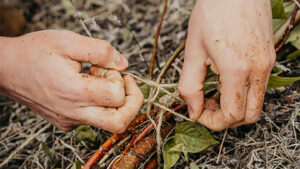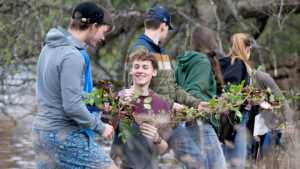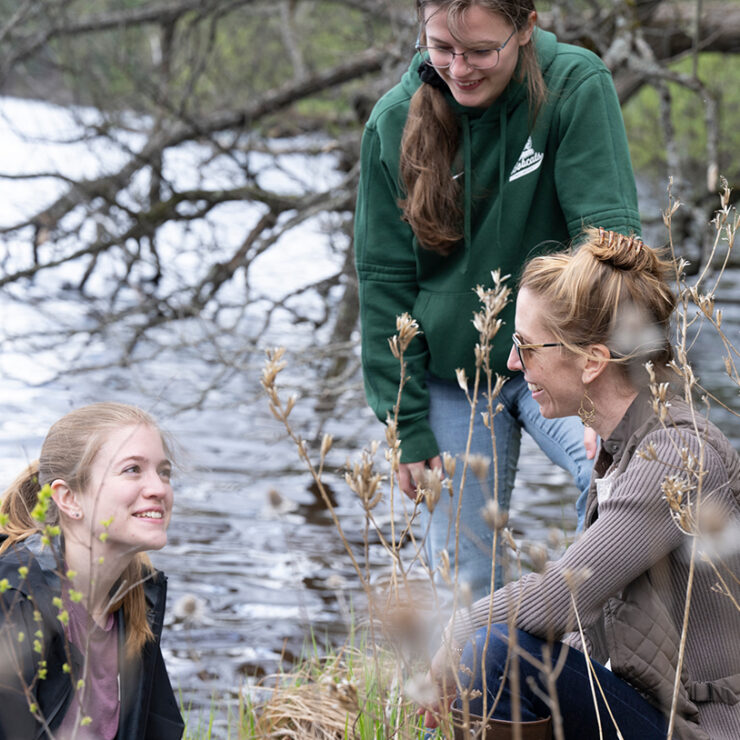This program equips students with a deep understanding of the interdependent relationships among aquatic and terrestrial ecosystems and the humans who populate them.
Bachelor of Science / 120 Credits
The United Nations has declared 2021-2030 the “UN Decade on Ecosystem Restoration,” offering incredible growth in career opportunities for professionals working to enhance food security, promote biodiversity, and address climate change. Paul Smith’s College’s Ecological Restoration program is at the cutting edge of this initiative.
With 14,000+ acres of biodiversity right here on campus, here’s what you’ll do:
- Participate in surveys of a variety of ecosystems: forests, lakes, streams and wetlands.
- Assess ecological conditions using biological communities (plants and animals).
- Design and implement projects to restore watersheds, rivers and streams, lakes and wetlands.
- Engage communities and encourage citizen science.
- The mission of the program is to prepare students to be future leaders in the emerging field of ecological restoration.
- Participate in collaborative planning and execution of ecological restoration projects by applying ecosystem knowledge and technical skills, by engaging communities and citizen participation and by using adaptive management. Our graduates will be able to articulate the relationship between ecosystem function and human health and well-being.
Program Details
Ecological Restoration Bachelor of Science 120 Credits
- Plant Biology
- General Ecology
- Chemistry I & II
- Geology
- Dendrology
- Introduction to GIS
- Ecosystem Courses
- Soils and Hydrology
- Forest Ecology
- Stream Ecology and Management
- Wetlands Ecosystems and Management
- Watershed Management
- Conservation Biology
- Ecological Restoration
- Restoration Ecology
- Restoration Ecologist
- Environmental Consultant
- Conservation Biologist
- Environmental Scientist
- Wetland Scientist
- Environmental Analyst
- Leader of Non-Profit
Unlocking Nature’s Secrets: In the field, ECOR majors harness the power of botany, soil science, hydrology. landscape ecology, and engineering principles to assess and rejuvenate degraded habitats. We decipher the essence of thriving ecosystems, crafting visionary restoration plans that not only yield results but captivate the public’s imagination. As ECOR graduates, you emerge equipped with the prowess to propose transformative solutions to global environmental challenges, no matter where they may arise.
In proactive partnership with local communities, we don’t just study; we roll up our sleeves and apply our knowledge.
|
Semester 1 |
||
|
BIO 110 |
Biology I |
3 |
|
ENG 101 |
Effective College Writing I |
3 |
|
ENV 110 |
Foundations of Environmental Science |
4 |
|
FYS 101 |
First Year Seminar |
3 |
|
MAT 125 |
Algebra |
3 |
|
Semester 2 |
Intro to Computer Apps |
3 |
|
BIO 112 |
Biology II |
3 |
|
FOR 110 |
Dendrology |
3 |
|
ENG 102 |
Effective College Writing II |
3 |
|
Humanities |
3 |
|
|
Social Science |
3 |
|
|
Semester 3 |
Natural Sciences |
3-4 |
|
BIO 210 |
General Ecology |
4 |
|
CHM 110 |
Chemistry I |
3 |
|
ECN 200 |
Principles of Economics |
3 |
|
Elective |
3-4 |
|
|
Semester 4 |
Humanities |
3 |
|
CHM 112 |
Chemistry II |
3 |
|
ENV 120 |
Geology |
3 |
|
or GEO 101 |
General Geography |
3 |
|
GIS 201 |
Introduction To GIS |
3 |
|
HUM 270 |
Ethics |
3 |
|
MAT 210 |
Statistics |
3 |
|
Semester 5 |
Elective |
3-4 |
|
BIO 204 |
Plant Biology |
3 |
|
FOR 330 |
Soils and Hydrology |
4 |
|
ENV 300 |
Restoration Ecology |
3 |
|
Elective |
3 |
|
|
Select any course. |
Responsibility & Expression – Integrated |
3-4 |
|
Semester 6 |
Elective |
3-4 |
|
ENV 330 |
Conservation Biology |
3 |
|
FOR 310 |
Forest Ecology |
3 |
|
ENV 340 |
Watershed Science |
3 |
|
Elective |
3-4 |
|
|
Elective |
4 |
|
|
Semester 7 |
Elective – UD |
3-4 |
|
ENV 471 |
Stream Ecology And Management |
3 |
|
ENV 473 |
Wetland Ecosystems and Management |
3 |
|
System Cluster |
3 |
|
|
Elective – UD |
3-4 |
|
|
Elective – UD |
3-4 |
|
|
Semester 8 |
Liberal Arts Elective |
3-4 |
|
ENV 400 |
Ecological Restoration |
3 |
|
SCI 495 |
Science Capstone |
4 |
|
Human System Cluster |
3 |
|
|
Elective |
3-4 |
|
|
Elective – UD |
4 |
|
|
HUMAN SYSTEM CLUSTER – CHOOSE 2 COURSES |
Track Cluster-UD |
3 |
|
Environmental Impact Assessment, Environmental Law and Regulatory Processes, Natural Resource Economics, Philosophy of Nature, Sustainable Development |
Elective-UD |
3 |
Ecological Restoration
Ecological Restoration


Questions? Let's get in touch.
Amanda Cording
Faculty
Associate Professor of Environmental Science
